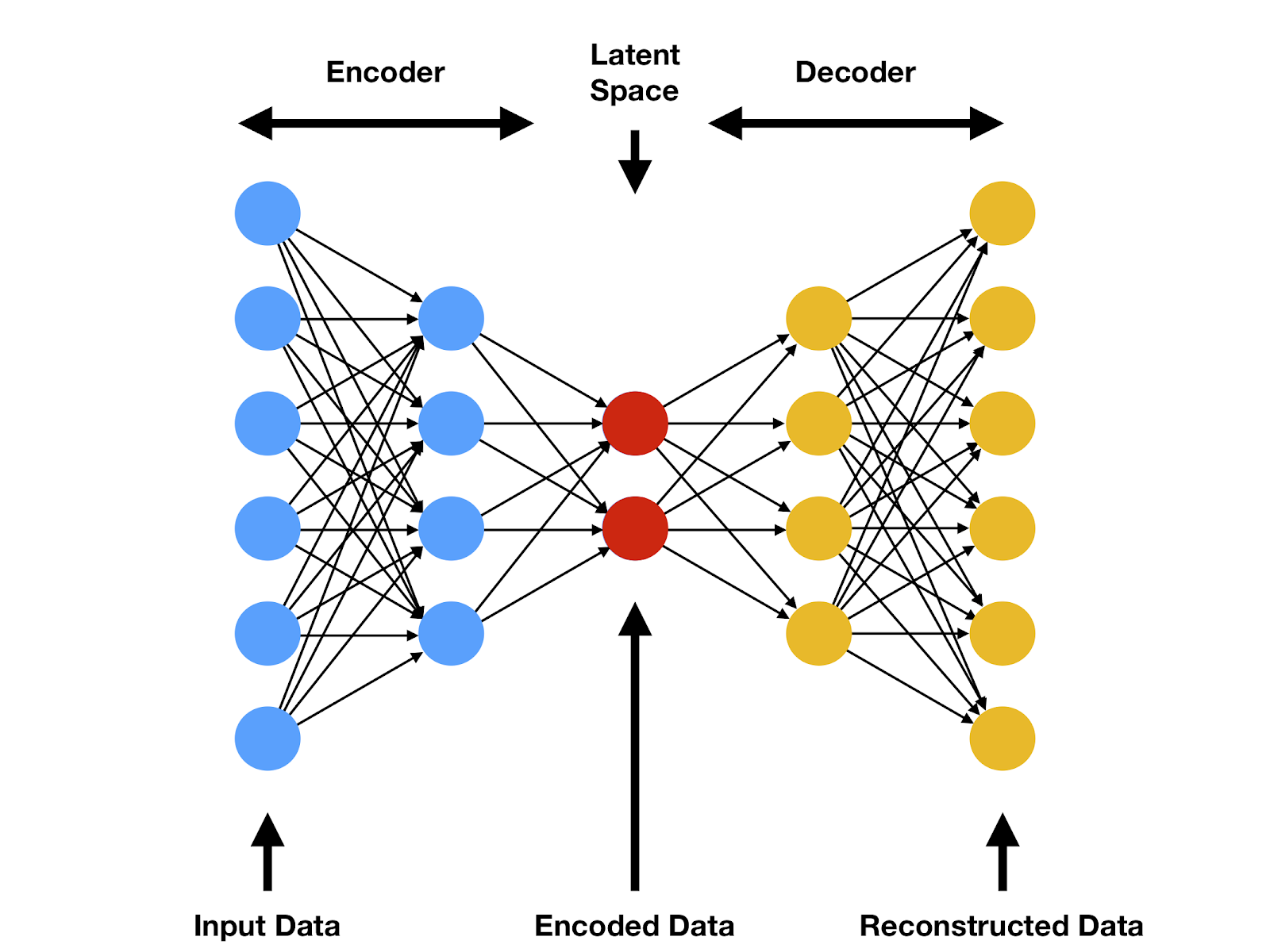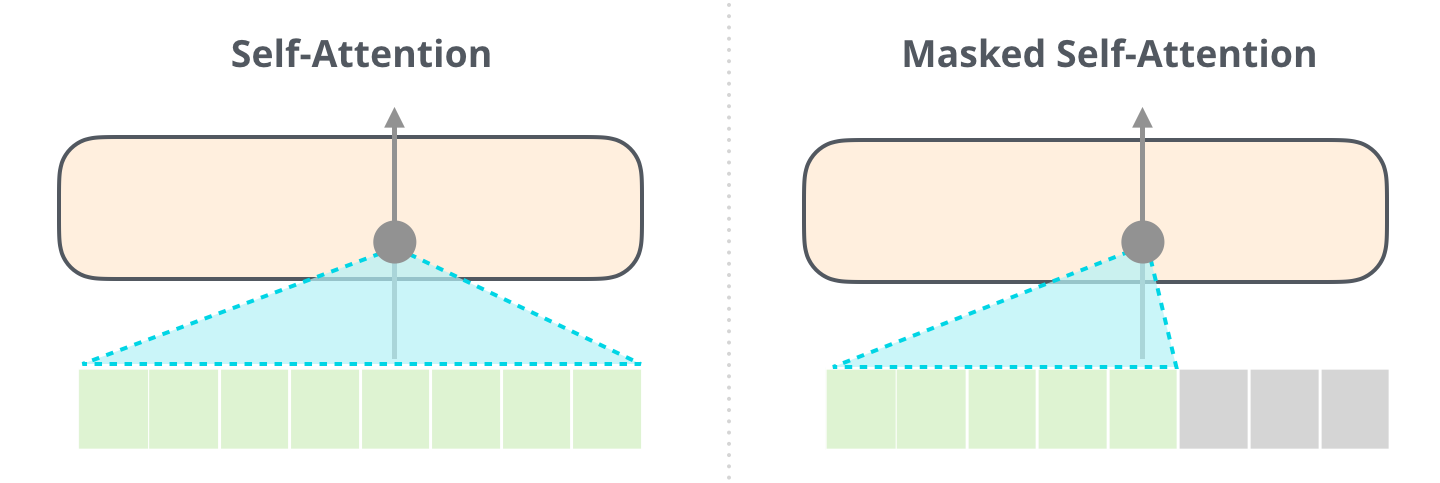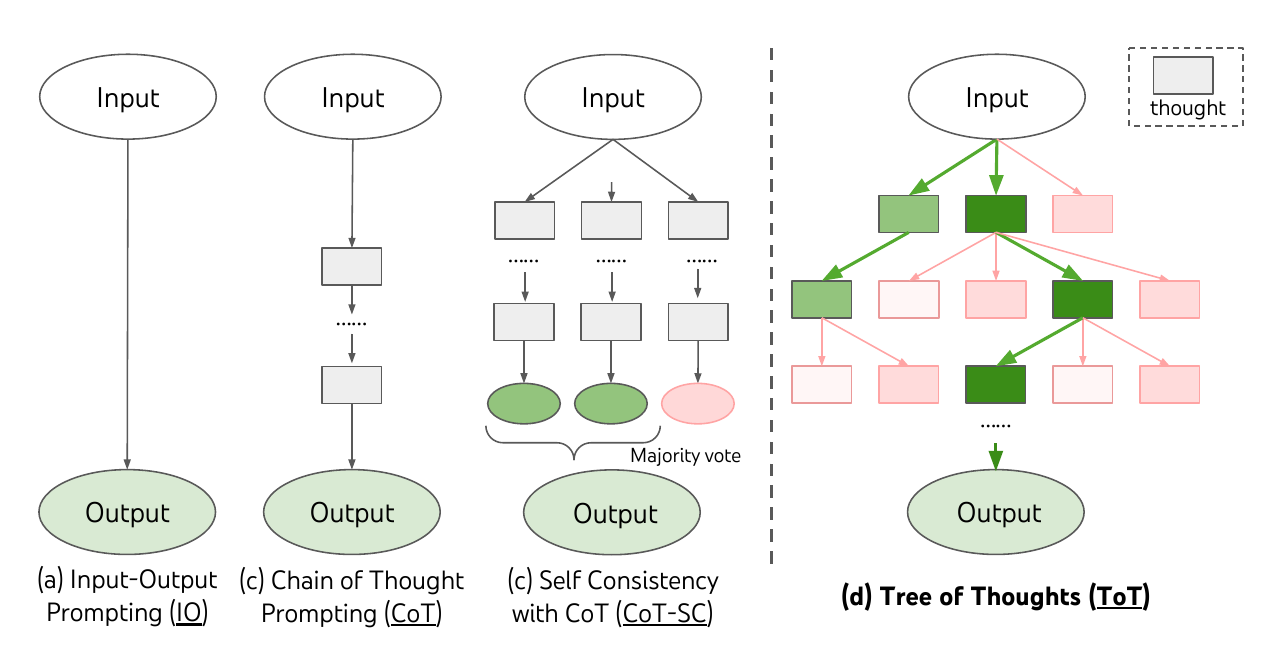Advanced Introduction to C++, Scientific Computing and Machine Learning
Claudius Gros, SS 2024
Institut for Theoretical Physics
Goethe-University Frankfurt a.M.
Generative Architectures
variational inference
conditional probabilities
- $\mathcal{D}\ $ : dataset with elements $(\mathbf{x},\mathbf{y})$,
$\mathbf{x}\ $ : input
$\mathbf{y}\ $ : output
- $\mathbf{w}\ $ : network parameters (weights)
- $P(\mathcal{D}|\mathbf{w})\ $ : conditional probability for
data $\mathcal{D}$, for a given configuration of $\mathbf{w}$
:: both $\mathbf{x}$ and $\mathbf{y}$ are given for supervised learning
accuracy objective
- $L^N(\mathbf{w},\mathcal{D})\ $ : network loss function
$$
L^N(\mathbf{w},\mathcal{D}) = -\log\big(P(\mathcal{D}|\mathbf{w})\big)
= - \sum_{(\mathbf{x},\mathbf{y})\in\mathcal{D}}
\log\big(P(\mathbf{y}|\mathbf{x},\mathbf{w})\big)
$$
- is minimal if there is one $\mathbf{y}$ for every $\mathbf{x}$
:: entropy is positive definite, vanishing in the absence of noise
variational inference
- $P(\mathbf{w}|\alpha)\ $ : prior distribution of weights
(before training), depending
on parameter $\alpha$
- $P(\mathbf{w}|\mathcal{D},\alpha)\ $ : posterior weight distribution
(given training data $\mathcal{D}$)
:: not tractable
- $P(\mathbf{w}|\mathcal{D},\alpha)$ is approximated by
$Q(\mathbf{w}|\beta)$, determined variationally, viz by
minimizing a given objective function
- $\mathcal{F}\ $ : variational free energy
$$
\mathcal{F} = - \left\langle \log\left[
\frac{P(\mathcal{D}|\mathbf{w})P(\mathbf{w}|\alpha)}{Q(\mathbf{w}|\beta)}
\right]\right\rangle_{\mathbf{w}\sim Q(\beta)}
$$
Kullback Leibler divergence
$$
\mathcal{F} = \left\langle L^N(\mathbf{w},\mathcal{D})
\right\rangle_{\mathbf{w}\sim Q(\beta)}
+ D_{\rm KL}\big(Q(\beta)\parallel P(\alpha)\big)
$$
- $\langle L^N(\mathbf{w},\mathcal{D})
\rangle_{\mathbf{w}\sim Q(\beta)}\ $ : parametrized
by $Q(\beta)$, instead of $\mathbf{w}$
- $D_{\rm KL}(Q(\beta)\parallel P(\alpha)) \ $ :
Kullback-Liebler divergence ('distance')
:: positive definite
:: $D_{\rm KL}\equiv 0\ $ if and only if
$Q(\beta)$ and $P(\alpha)$ identical
:: converged if posterior $\equiv$ prior
variational distributions
- minimization procedure possible for a given
parametrization of $Q(\mathbf{w},\beta)$
- Gaussian: mean $\mu_i$ and standard deviation $\sigma_i$ for
parameter $w_i$
- same parametrization for prior $P(\mathbf{w}|\alpha)$
inference
- result is a distribution, parametrized by $(\mu_i,\sigma_i)$,
for network parameters: not a single value
- set of $(\mu_i,\sigma_i)$ updated with every new observation,
:: viz with every new data $(\mathbf{x},\mathbf{y})$
:: inference: updating of a distribution with new observations
- next step: start posterior as new prior
:: $(\mu_i,\sigma_i)$ are now the parameters of the prior
variational autoencoder
- latent space ('encoded space')
- for normal autoencoder
:: not structured, just a bottleneck
- for variational autoencoder
:: maximal information
- maximize information when encoding
- minimized reconstruction error when decoding
- $\mathbf{x}\ $ : input
$\mathbf{z}\ $ : latent state
$\mathbf{y}\ $ : output
probabilistic network representations
- $Q(\mathbf{w}|\beta)\ $ : encoder
$Q^\prime(\mathbf{w}^\prime|\beta^\prime)\ $ : decoder
:: probabilities to generated networks parameters
$\mathbf{w}\,/\,\mathbf{w}^\prime$
:: encoded by variational parameters
$\beta\,/\,\beta^\prime$ (Gaussians)
accuracy target
- $P(\mathbf{y}|\mathbf{z},\mathbf{w}^\prime)\ $ :
probability to find $\mathbf{y}$ for given $\mathbf{z}$
and $\mathbf{w}^\prime$
$$
\mathcal{F}_{\mathrm{accuracy}} =
- \sum_{(\mathbf{x},\mathbf{y})\in\mathcal{D}}
\log\big(P(\mathbf{y}|\mathbf{z},\mathbf{w}^\prime)\big)
$$
- $\mathbf{y}\hat{=}\mathbf{x}\ $ for autoencoder
- minimal if there is an $\mathbf{y}$ for every $\mathbf{z}$
information maximization
- variational inference between input and latent space
- posterior and prior (both variational)
$$
\mathcal{F}_{\mathrm{information}} = D_{\mathrm{KL}}
\big(P_{\mathrm{posterior}} \parallel P_{\mathrm{prior}}
\big)
$$
$$
P_{\mathrm{prior/posterior}} =
P(\mathbf{z}|\mathbf{x},\mathbf{w})\Big|_{\mathrm{before/after\ updating}}
$$
natural language processing (NLP)
encoder-decoder architectures for NLP
- encoder
every layer receives an input
$
\mathbf{h}_{t} = \mathbf{f}(\mathbf{h}_{t-1}, \mathbf{x}_t)
$
$\mathbf{h}_{t}\ $ : hidden layer state
$\mathbf{x}_{t}\ $ : input (embedded words)
- decoder
every layer makes a prediction,
receiving previous predictions as input
$
\mathbf{s}_{t} = \mathbf{g}(\mathbf{s}_{t-1}, \mathbf{y}_{t-1})
$
$\mathbf{s}_{t}\ $ : hidden layer state
$\mathbf{y}_{t}\ $ : predicted word (linear classifier, softmax)
word embedding
- preprocessing: word $\to$ vector
- consider inter-word correlations
:: related words are closer in vector space
- example: Google Word2vec
variants
- apply to
- variational encoders, decoders, and/or
- recurrent neural networks (RNN)
- normal units / long short-term units
- state-of-the-art until 2014-2017
semantic correlations
If the universe has an explanation of its existence,
that explanation is God.
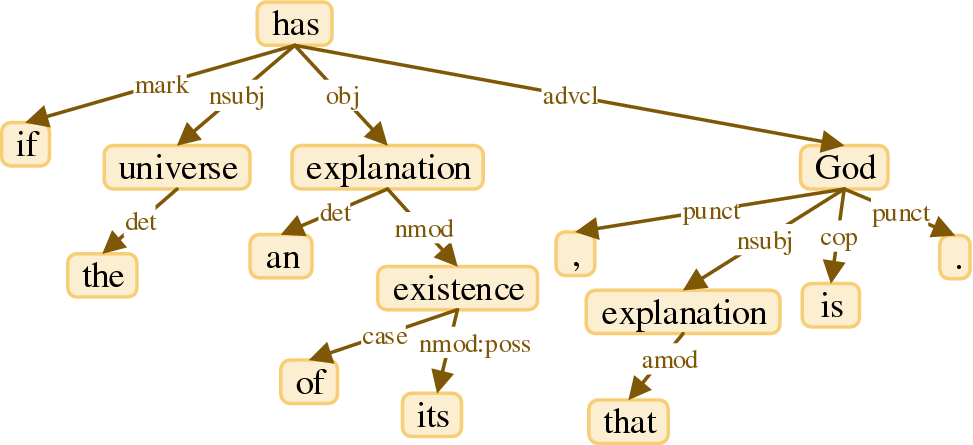
- posibly long-distance semantic correlations
- classical approach: memory (fading)
- state-of-the-art: attention
query, key & value
- $\sim0.75$ word -- tokens
$\sim 5\cdot10^4$: vocabulary size
- activity $\ \mathbf{x}$: current state
- three matrices (entries adapted via backpropagation)
$\hat{Q}\ $: query
$\hat{K}\ $: key
$\hat{V}\ $: value
- $\mathbf{Q}$, $\mathbf{K}$, $\mathbf{V}$ vectors
$$
\mathbf{Q} = \hat{Q}\cdot\mathbf{x},\qquad
\mathbf{K} = \hat{K}\cdot\mathbf{x},\qquad
\mathbf{V} = \hat{V}\cdot\mathbf{x},\qquad
$$
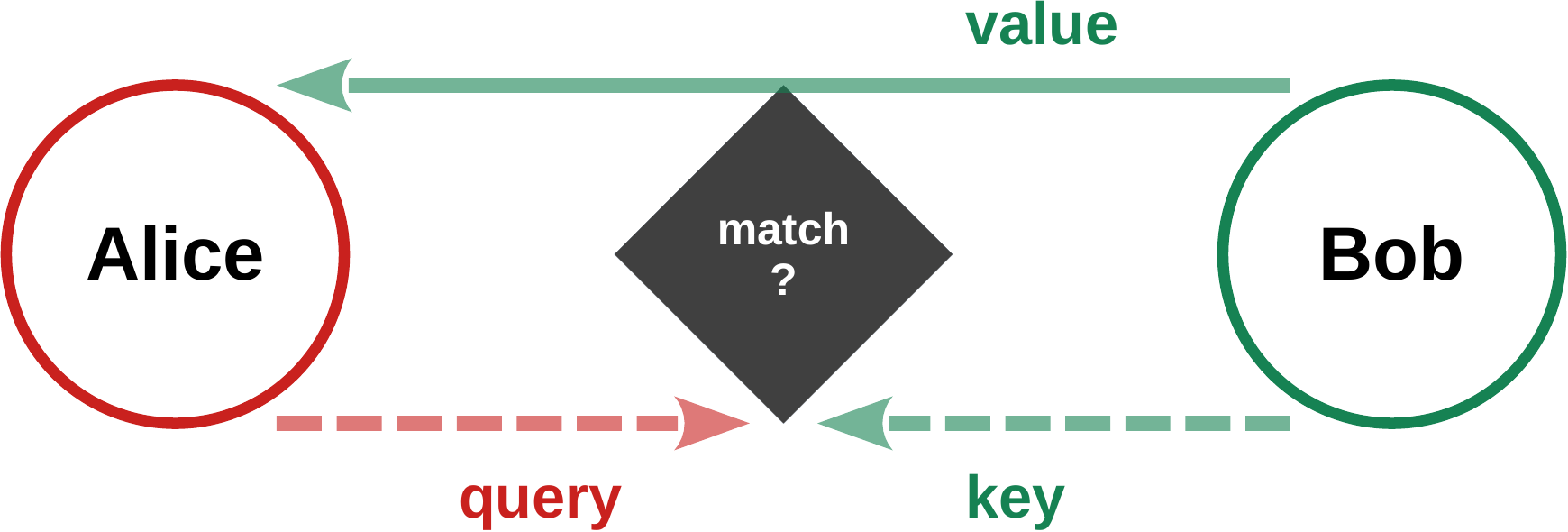
Alice: should I pay attention to Bob?
- databank query formalism
- Alice sends its query $\ \mathbf{Q}_A\ $ to Bob
- Bob compares $\ \mathbf{Q}_A\ $ with its key $\ \mathbf{K}_B$
- if there is a match, sends back its value $\ \mathbf{V}_B$
- content-based attention via similarity
- self attention: between words of a sentence
dot-product attention

- scanning keys for similarity with query
$\mathbf{K}_j \ $ : key of object
$\mathbf{V}_j \ $ : value of object
$\mathbf{Q}_{\phantom{j}} \ $ : query
$$
\mathbf{a} = \sum_j \alpha_j\mathbf{V}_j,
\quad\qquad
\alpha_{j} = \frac{\mathrm{e}^{e_{j}}}{\sum_i\mathrm{e}^{e_{i}}}
\quad\qquad
e_{j} = \mathbf{Q}\cdot\mathbf{K}_{j}
$$
- $\mathbf{a}\ $ : attention vector
:: activity of query token
:: output of attention layer
- softmax (Boltzman distribution) superposition of values
- similarity: scalar product
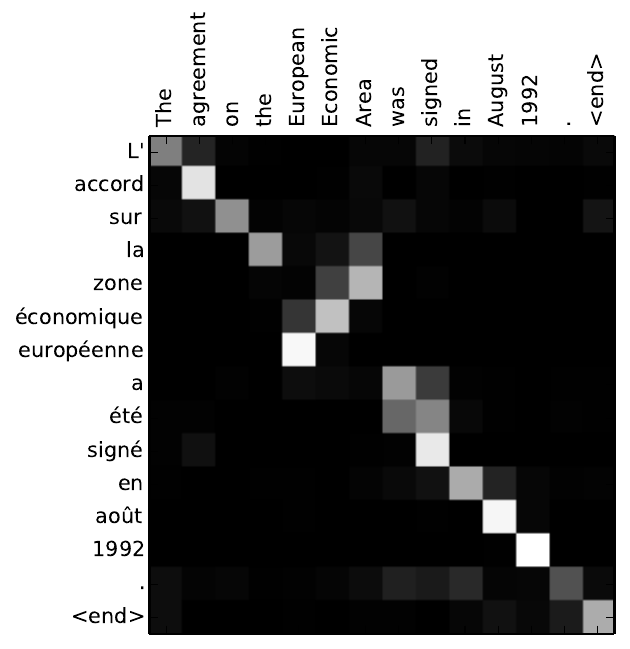 [Bahdanau, Cho, Bengio 2014]
[Bahdanau, Cho, Bengio 2014]
transformer block

$$
\begin{array}{ccccccc}
\fbox{$\phantom{\big|}\mathrm{input}\phantom{\big|}$}
&\to&
\fbox{$\phantom{\big|}\mathrm{attention}\phantom{\big|}$}
&\to&
\fbox{$\phantom{\big|}\mathrm{normalization}\phantom{\big|}$}
& &
\\[0.5ex]
&\to&
\fbox{$\phantom{\big|}\mathrm{feed forward}\phantom{\big|}$}
&\to&
\fbox{$\phantom{\big|}\mathrm{normalization}\phantom{\big|}$}
&\to&
\fbox{$\phantom{\big|}\mathrm{output}\phantom{\big|}$}
\end{array}
$$
- input sentence
:: embedded sequence of words (tokens)
- residual connections around attention layer are essential
- MLP: linear feedword layer:
- output of block $\ \equiv\ $ input of next block
multi-headed attention
- $h\ $ attention blocks in parallel ($h=8$)
:: every token generates $\ h \ $ Q/K/V matrices
- allows for context specific attention
skip connections
skip/residual connections
- add identity in parallel to hidden layer
$\mathbf{Layer}(\mathbf{x}) \ \to \
\mathbf{x}+\mathbf{Layer}(\mathbf{x})$
- additional normalization (transformer model)
$\mathbf{Norm}\Big(\mathbf{x}+\mathbf{Layer}(\mathbf{x})\Big)$
advantages
- helps with vanishing gradient problem
when backprogating learning signals
during the training of deep networks
- if layer is superfluous, training can ignore it
- allows to add (self-) attention layers (transformer model)
positional encoding
- NLP before transformer (2017)
:: read word by word
:: encoder / decoder with RNN and LTSM
- NLP with transformer
:: reading sentence by sentence
:: no RNN, no LTSM; good for parallelization, GPUs
:: uses self-attention with positional encoding
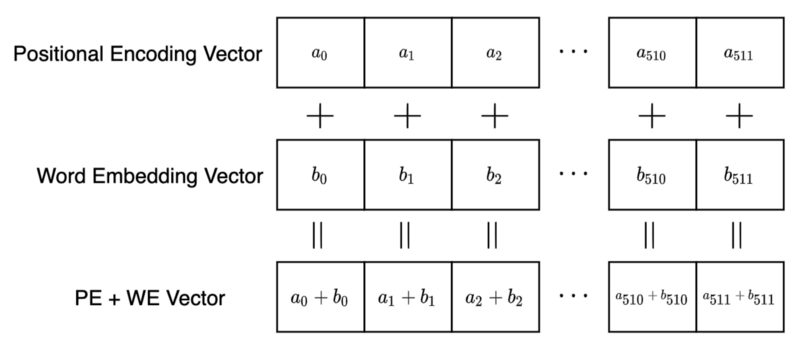
position of words in a sentence
- system needs position information when
reading entire sentences at once
- for every word:
$\mathbf{P}_e\ $ : positional encoding vector
$\mathbf{W}_e\ $ : word embedding vector
- transformer architecture
$\mathbf{P}_e$ and $\mathbf{W}_e$ have identical dimension
$d_{\mathrm{model}}=512 \ $ : model dimension
- encoder input:
$\mathbf{P}_e + \mathbf{W}_e\ $ : vector sum (times number of words)
discrete fourier analysis
- many types of positional encodings possible
transfomer uses fourier components
- $L_s\ $ : length of input sentence
$k\ $ : word position
$d_{\rm model}\ $ : embedding dimension
$i\in[0,d_{\rm model}/2]\ $ : encoding the embedding index
$$
P_e(k,2i ) = \sin\left(\frac{k}{K^{2i}}\right),
\quad\qquad
P_e(k,2i+1) = \cos\left(\frac{k}{K^{2i}}\right),
\quad\qquad
K = n^{1/d_{\mathrm{model}}}
$$
- for $d_{\rm model}=512$ (transformer), one has
a geometric series of
$d_{\rm model}/2=256\ $ wavevectors $\ K^{2i}=1,\dots,n$
- $n=10^4\ $ (transformer)
- for the $k$th word, $P_e(k,j)$ is the $j$th entry
of the positional embedding vector
recursive prediction
hello $\ \to\ $ hello

- own prediction $\ \equiv\ $ input (shifted by one token)
beam search
not the most likely individual words/characters,
but the most likely sentences
- run for the N mostly likely first words
- run for the N mostly likely two-word combinations
- ...
beam search
- large language models (LLMs) generate
probabilities for output tokens
:: words, syllables, letters
- greedy
take token with highest probabilty
- chatGPT uses beam search
beam search
- classical search algorithm for probalistic trees
- N=2: width of search beam
- first position:
select the N tokes with highest probabilities:
A and C
- rerun system N times, with first position fixed
:: generate new probabilities for second position
- evaluate combined probalities $\ \ p_{AX}$, $\ \ p_{CX}$
for all second-position tokens $\ X$
- select N highest 2-token combinations: AB and CE
- rerun N times with fixed first/second positions
- ... repeat


combined probabilities
- position of output token: time step
- left (greedy)
$0.5\cdot0.4\cdot0.4\cdot0.6=0.048$
- right (non-greedy second position)
$0.5\cdot0.3\cdot0.6\cdot0.6=0.054$
- changed probabilities due to rerun
masked self attention
ordered input tokes
- attention to the left only (causality)
- value, key, query
$
\mathbf{V}_m = \hat{V}_m \cdot \mathbf{x}_m,
\qquad
\mathbf{K}_m = \hat{K}_m \cdot \mathbf{x}_m
$
$
\mathbf{Q}_m = \hat{Q}_m \cdot \mathbf{x}_m
$
$$
\begin{array}{rcl}
\mathbf{s}_q^{\mathrm{(head)}} &= &
\sum_k \mathbf{V}_k\,
\mathrm{softmax}\Big(F_a(\mathbf{K}_k,\mathbf{Q}_{q})\Big)
\\[0.5ex] &\to&
\frac{\sum_k\mathbf{V}_k \big(\mathbf{K}_k\,\cdot\,\mathbf{Q}_{q}\big)}
{\sum_k \mathbf{K}_k\,\cdot\,\mathbf{Q}_{q}}
=
\frac{\big(\sum_k \mathbf{V}_k \otimes\mathbf{K}_k\big)\,\cdot\,\mathbf{Q}_{q}}
{\big(\sum_k \mathbf{K}_k\big)\,\cdot\,\mathbf{Q}_{q}}
\end{array}
$$
- outer product: $\ \otimes$
- additionally: positiveness
associative soft weight computing
- enters linearized attention (mean-field approximation)
:: $\ W_{\rm tot}=\sum_k \mathbf{V}_k \otimes\mathbf{K}_k$
$$
W_m = W_{m-1} + \mathbf{V}_m \otimes\mathbf{K}_m
$$
- akin to time decomposition of a autoassociative recurrent net
:: internal state: $\ W_m$
- key-value associations
$$
\mathbf{V}_m \otimes\mathbf{K}_m =
\mathbf{x}_m\,\cdot\,\big(\hat{V}_m \otimes\hat{K}_m
\big)\,\cdot\,\mathbf{x_m}
$$
why does it work?
attention in neuroscience / psychology
- external (saliency, 'something fast')
- top-down attention commands
:: 'looking for a red object'
$\color{brown}\Rightarrow \ $ humunculus problem
-
“No one knows what attention is” [Hommel et al., 2019]
ML attention
active during training
$\ \color{brown}\Rightarrow\ $ self-consitency loop
- Q, K, V matrices adapt to Q-K matching condition
:: dot product
- attention $\ \color{brown}\equiv\ $ information routing
:: self-optimized information bootleneck
self-optimized information routing
solves the fitting / generalization dilemma
- statistical learning of causal relations
:: not (only) of information
foundation models
GPT - generative pretrained transformer
- number of adaptable parameters (matrix elements)
:: $10^8$ / $10^9$ / $10^{11}$ / $10^{12}$
:: GPT 1 / 2 / 3 / 4
- $10^3-10^4\ $ context tokens, $\ \sim 80\ $ layers
automatic pretraining
by predicting next word
$
\begin{array}{rl}
{\color{red}\equiv} & \mathrm{base\ mode\ (GPT\!-\!3)} \\[0.0ex]
{\color{red}+} & \mathrm{human\ supervised\
finetuning\ (SFT\ model)} \\[0.0ex]
{\color{red}+} & \mathrm{human\ supervised\ reinforement\
learning} \\[0.0ex]
{\color{red}\Rightarrow} & \mathrm{chat\ assistent\ (foundation\ model)}
\end{array}
$
- SFT: $\ 10^4\!-\!10^5\ $ hand-crafted (prompt, response) pairs
:: learns to answer; ¬(text completion)
applications / tasks on top of
foundation model

value alignment
reinforcement learning from
human feedback (RLHF)
- reinforcement learning
:: learning from feedback
- humans train the reward model
the reward model trains GPT
:: circumvents behavioral cloning
$\color{brown}\Rightarrow\ $ value alignment
$\color{brown}\Rightarrow\ $ ChatGPT

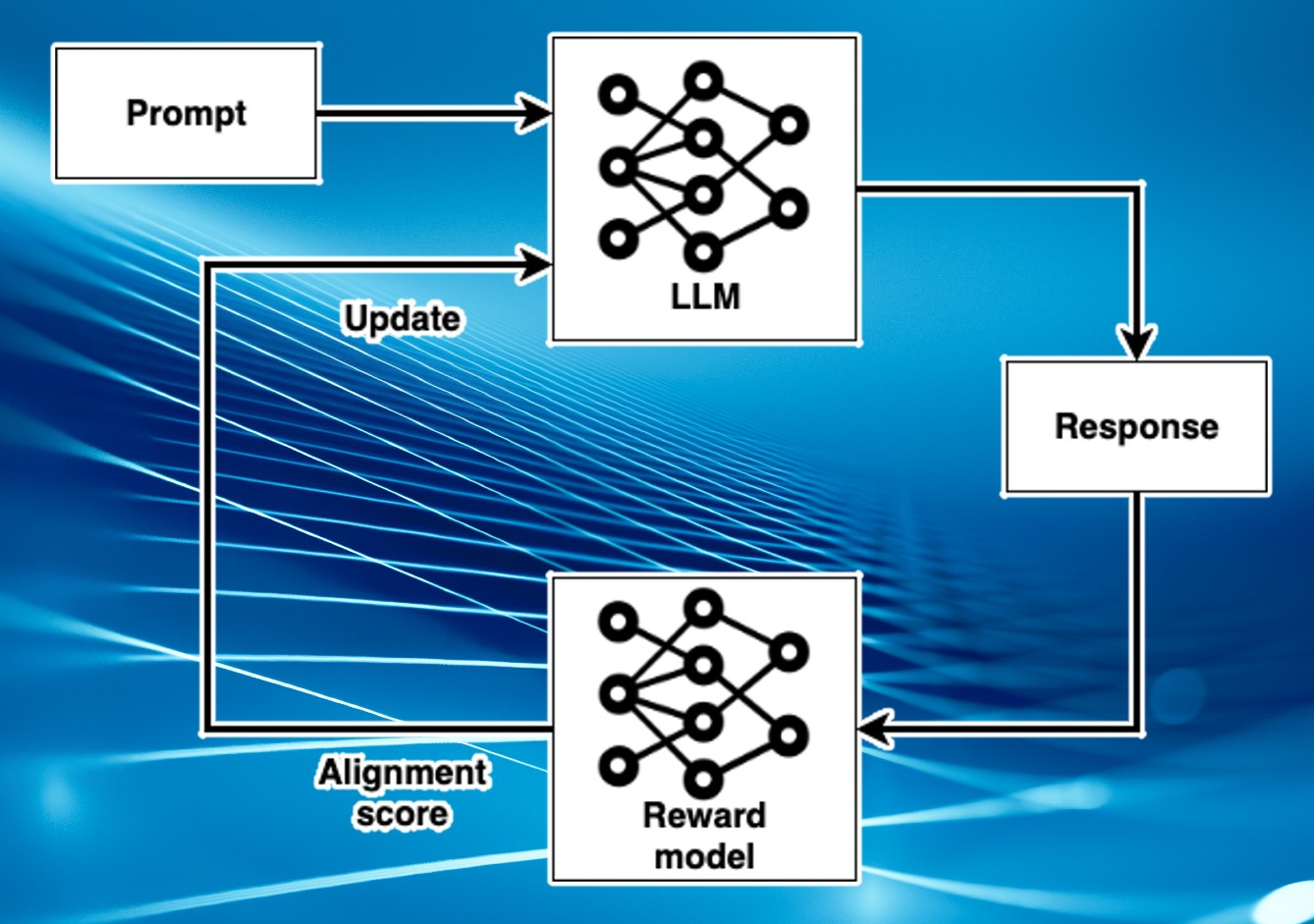
open-source explosion
LLaMA (Meta AI)
- public release Feb 2023
:: 7B, 13B, 33B, and 65B parameters
:: parameters leaked within a week
-
'We have no moat'
- leaked Google memo, May 2023
Open-source models are faster, more customizable,
more private, and pound-for-pound more capable.
They are doing things with $\$$100 and 13B params that
we struggle with at $\$$10M and 540B. And they are doing
so in weeks, not months.
The barrier to entry for training and experimentation
has dropped from the total output of a major research
organization to one person, an evening, and a beefy laptop.
AI psychology
[Yao et.al, 2023]
Tree of Thoughts:
Deliberate Problem Solving with Large Language Models
- helping large language models to 'think'
:: substantial performance boost
potential problems
value alignment
- democratic / liberal for most western chatBots
:: no opinion given
- possible alternative value alignments
:: socialist / suppressive (China)
:: religious, e.g. islamic
:: ...
copyright
- training corpus
- ¬(generated text)
social media polution
- mass generation of social media posts
:: value marketing
$\to\ \ $ training data polution
regulation
- data privacy / age verification / risk of wrong answers (Italy)
- EU AI act (dangerous applications)
- however, open-source explosion
:: regulation no possible?
